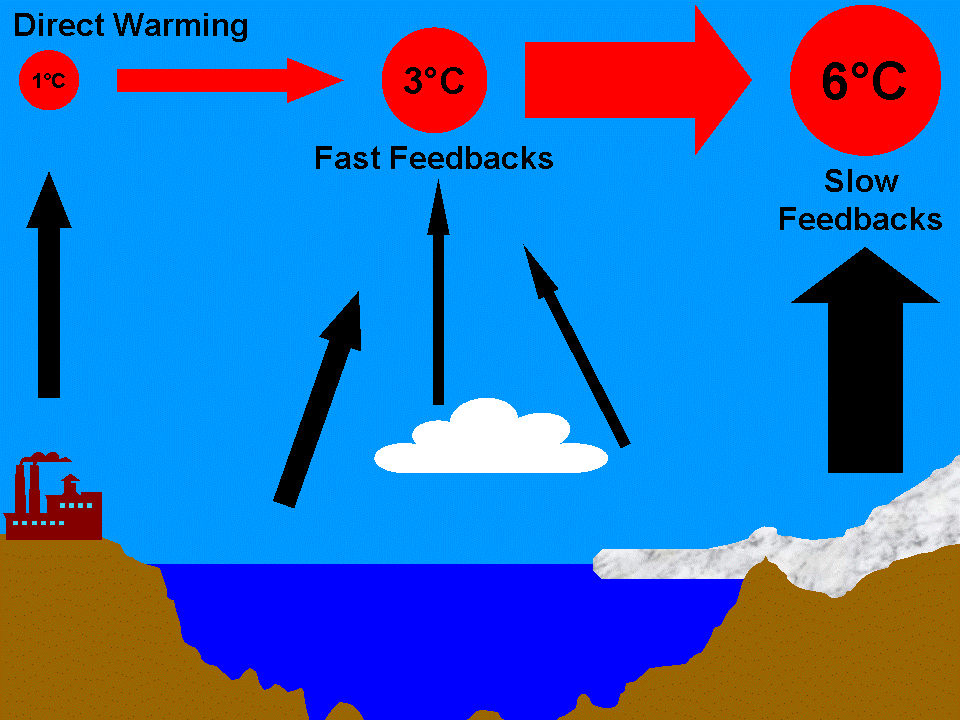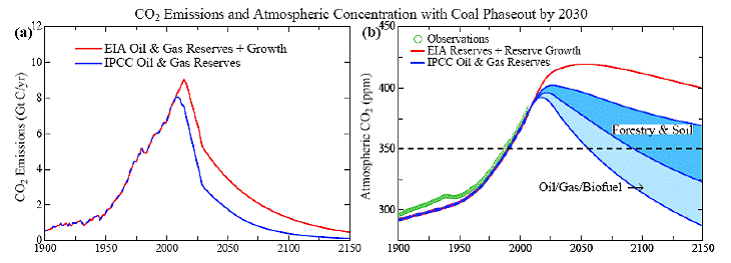Climate Emergency: Time to Slam on the Brakes
Posted on 8 March 2011 by James Wight
Global warming is an increasingly urgent problem. The urgency isn’t obvious because a large amount of warming is being delayed. But some of the latest research says if we want to keep the Earth’s climate within the range humans have experienced, we must leave nearly all the remaining fossil fuels in the ground. If we do not act now we could push the climate beyond tipping points, where the situation spirals out of our control. How do we know this? And what should we do about it? Read on.
James Hansen, NASA’s top climatologist and one of the first to warn greenhouse warming had been detected, set out to define dangerous human interference with climate. In 2008, his team came to the startling conclusion that the current level of atmospheric carbon dioxide (CO2) is already in the danger zone.
Since the Industrial Revolution, atmospheric CO2 has increased from 280 to 390 parts per million (ppm). Don’t be fooled by the small number – 390 ppm is higher than CO2 has been in millions of years. CO2 is rising by 2 ppm per year as we continue to burn fossil fuels. To stabilise the Earth’s climate, we must reduce CO2 to the relatively safe level of 350 ppm. And we must hurry, because the task will soon be an impossible one.
The 350 target is based not on climate modeling, but on past climate change (“paleoclimate”). Hansen looked at the highly accurate ice core record of the last few hundred thousand years, sediment core data going back 65 million years, and the changes currently unfolding. He discovered that, in the long term, climate is twice as sensitive in the real world as it is in the models used by the IPCC.
The key question in climate modeling is how much global warming you get from doubling CO2, once all climate feedbacks are taken into account. A feedback is something that amplifies or cancels out the initial effect (eg. interest is a feedback on a loan). The models include “fast feedbacks” like water vapor, clouds, and sea ice, but exclude longer-term “slow feedbacks” like melting ice sheets (an icy surface reflects more heat than a dark surface).
Both models and paleoclimate studies agree the warming after fast feedbacks is around 3°C per doubling of CO2. Slow feedbacks have received far less attention. Paleoclimate is the only available tool to estimate them. To cut a long story short, Hansen found the slow ice sheet feedback doubles the warming predicted by climate models (ie. 6°C per CO2 doubling).

The global climate has warmed only 0.7°C, but has not yet fully responded to our past emissions. We know this because the Earth is still gaining more heat than it is losing. There is further warming in the pipeline, and Hansen’s results imply there’s a lot more than in the models. If CO2 remains at 390 ppm long enough for the ice sheet feedback to kick in, the delayed warming would eventually reach 2°C. That would result in an Earth unlike the one on which humans evolved and a sea level rise of not one metre, not two metres, but 25 metres. Imagine waves crashing over an eight-storey building.
It’s hard to dispute this would be “dangerous” climate change. But how quickly could it happen? In the past, ice sheets took millennia to respond, though once they got moving sea level rose several metres per century. But maybe ice sheets can melt faster if CO2 rises faster, as it is now doing. The IPCC predicted they would grow by 2100, but instead they are starting to shrink “100 years ahead of schedule”. Once an ice sheet begins to collapse there is no way to stop it sliding into the ocean. We would suffer centuries of encroaching shorelines. The climate change we started would proceed out of our control.
If ice sheets can melt significantly this century, then Hansen’s long-term warming has near-term policy implications. The tragedy we have set in motion can still be prevented, if we get the Earth to stop accumulating heat before slow feedbacks can kick in. To do so we must target the greatest, fastest-growing, and longest-lived climate driver: CO2.
Under business as usual, we are heading for up to 1,000 ppm by 2100, or nearly two doublings (and that’s not including possible carbon feedbacks). This would surely be an unimaginable catastrophe on any timescale. Even the mitigation scenarios governments are quarreling over are based on IPCC assessments now several years out of date. The lowest CO2 target being considered is 450 ppm, which Hansen concluded would eventually melt all ice on the planet, raising sea level by 75 metres. The Earth has not been ice-free since around the time our distant ancestors split off from monkeys.
Instead of stepping on or easing off the accelerator, we need to be slamming on the brakes. We must not only slow the rise of CO2 in the atmosphere, but reverse it. We must reduce CO2 from 390 to 350 ppm as soon as possible. That should stop the planet’s accumulation of heat. Stabilizing the CO2 level will require rapidly reducing CO2 emissions until nature can absorb carbon faster than we emit it – in practical terms, cutting emissions to near zero.
The only realistic way of getting back to 350 ppm is leaving most of the remaining fossil fuels in the ground. We must:
1) phase out coal by 2030. It is not enough to slow down coal-burning by converting it to liquid fuels, because CO2 stays in the atmosphere for a very long time. The fundamental problem is with the coal being burned at all.
2) not burn tar sands or oil shale. Their reserves are virtually untapped but thought to contain even more carbon than coal. Canada cannot keep burning them.
3) not burn the last drops of oil and gas if their reserves are on the high side. If it turns out we have already used about half, then we can safely burn the rest.
4) turn deforestation into reforestation. We’d still be left with the gargantuan task of removing CO2 from the atmosphere. Nature can absorb some carbon, but it has limits.

It won’t be easy, but with these actions CO2 could peak around 400 ppm as early as 2025 and return to 350 ppm by century’s end. I believe we can achieve this; it’s primarily a question of political will. But our window of opportunity is rapidly slamming shut. Even one more decade of business as usual, and CO2 can be expected to remain in the danger zone for a very long time.
I should point out estimating a CO2 target from paleoclimate is fraught with uncertainties. I’ve had to simplify for this short article. I explain in more detail on Skeptical Science, or you can read Hansen’s paper free here. If there is one lesson recent climate research should teach us, it is that it’s a mistake to call uncertainty our friend. Arguably the most important aspect Hansen ignores, carbon feedbacks, is likely to make things even worse. There is more than enough reason to heed Hansen’s warning.
Right now we stand at an intersection. What we do in this decade is crucial. If we choose one path, by the end of the decade the world could be well on its way to phasing out coal. If we choose the other, we face an uncertain future in which the only certainty is a continually shifting climate. I’ll leave the final word to Hansen et al, whose concluding statements were pretty strongly worded coming from a dense, technical, peer-reviewed paper:
Present policies, with continued construction of coal-fired power plants without CO2 capture, suggest that decision-makers do not appreciate the gravity of the situation. We must begin to move now toward the era beyond fossil fuels. […] The most difficult task, phase-out over the next 20-25 years of coal use that does not capture CO2, is Herculean, yet feasible when compared with the efforts that went into World War II. The stakes, for all life on the planet, surpass those of any previous crisis. The greatest danger is continued ignorance and denial, which could make tragic consequences unavoidable.
Editor's Note: Many thanks to James who wrote this blog post which is also the Basic Rebuttal to the argument "It's not urgent" (if you ever encounter this argument, just point people to http://sks.to/urgent ). James originally wrote a much longer blog post but I asked him to shorten it (the longer version now acts as the Advanced Rebuttal). So he patiently rewrote a much shorter version which I asked to shorten again (that version now acts as the Intermediate Rebuttal). In this final version, James informed me, "I cannae shorten it no more, captain!"































 Arguments
Arguments






























This appears to be extremely alarming. However, Hansen's predictions have not always been proved to be close to reality as I describe below.
The global warming models presented by Hansen (2006) are shown in Figure 1. I have added the GISS Land Ocean Temperature Index (LOTI) data up to January 2011 and I have also added the Mauna Loa CO2 data.
The blue line in Figure 1 denotes the GISS LOTI data and the black line is the Mauna Loa CO2 data. Scenarios A, B and C describe various CO2 emission outcomes presented by Hansen (2006).
Scenario A is "on the high side of reality" with an exponential increase in emissions. Scenario C has "a drastic curtailment of emissions", with no increase in emissions after 2000. Scenario B is described as "most plausible" which is expected to be closest to reality.
Nevertheless, it is interesting to note that in his testimony to US Congress, Hansen (1988) describes Scenario A as "business as usual." This somewhat contradicts "on the high side of reality" in Hansen (2006) in which Scenario B is described as "most plausible." Don't we all have 20-20 vision with hindsight?
It is evident from Figure 1 that CO2 emissions are following Hansen's Scenario A temperatures (forcings) whilst real-world temperatures are following the "zero increase in emissions" Scenario C. What temperature do you get by doubling CO2? It would appear that we would get a lot less than predicted by Hansen (2006).
James perhaps you worry too much. "Facts are chiels that winnae ding." The real-world currently does not seem inclined to follow Hansen's (2006) predictions.Notwithstanding the above, it should be noted that time period for the comparison of actual temperature/CO2 measurements with those predicted is still relatively short. Hansen (2006) suggests that we could expect reasonable results for distinction between the scenarios and useful comparison with the real world by 2015.
"Remarkably, the presented records allow direct comparison of recent warming with former warm intervals such as the Roman or the Medieval periods. That comparison reveals the 20th Century as the time with highest surface temperatures of the last 4000 years for the studied area."
Albatross @67
I am not aware of any misinformation in my post. All of the data presented by me is in the public domain and is available from the links in my post. Please point out where I am "perpetuating misinformation" and I will make appropriate corrections, otherwise a retraction from you would appear to be appropriate.